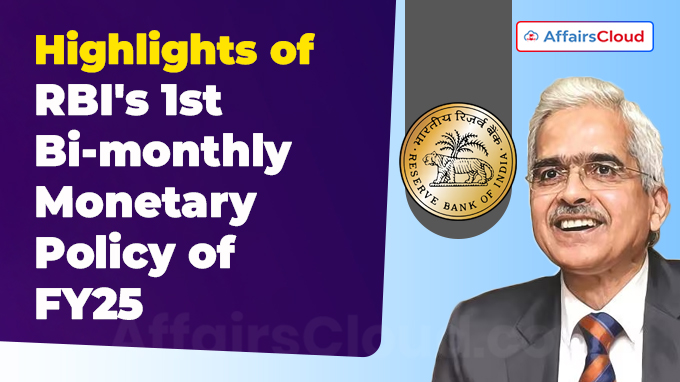
- The stance is to focus on withdrawal of accommodation to ensure that inflation progressively aligns with the target, while supporting growth.
RBI’s Policy Rates:
The MPC kept the policy rates unchanged.
| Category | Rate |
|---|---|
| Policy Repo Rate | 6.50% |
| Fixed Reverse Repo Rate | 3.35% |
| Standing Deposit Facility (SDF) Rate | 6.25% |
| Marginal Standing Facility (MSF) Rate | 6.75% |
| Bank Rate | 6.75% |
| Cash Reserve Ratio (CRR) | 4.50% |
| Statutory Liquidity Ratio (SLR) | 18% |
- RBI kept the repo rate unchanged at 6.5% for 7th consecutive time to reduce inflation and make sure people expect lower prices while ensuring it works effectively. The committee decided this with a majority of 5:1.
- The repo rate is the rate at which the RBI lends to commercial banks.
Inflation:
i.Consumer Price Index (CPI) inflation or retail inflation is projected at 4.5% (unchanged vis-a-vis February 2024 projection) for FY25, with FY25’s Q1 at 4.9%, Q2 at 3.8%, Q3 at 4.6%, and Q4 at 4.5%.
- This forecast is on the assumption of normal monsoon.
ii.RBI set an objective of achieving the medium-term target for CPI inflation of 4% within a band of +/- 2%, while supporting growth.
iii.CPI core disinflation, excluding food and fuel, dropped to 3.4% in February 2024, marking one of the lowest points in the current CPI series, with both goods and services seeing a decrease in inflation.
- Fuel prices also remained in deflation for the 6th consecutive month in February.
Domestic & Global Economy:
i.With Respect to the domestic economy, real GDP expanded by 7.6% in 2023-24 (FY24) , driven by robust domestic demand and investment activity, as per the Second Advance Estimates (SAE) of National Income, 2023-24 by National Statistical Office (NSO), Ministry of Statistics and Programme Implementation (MoSPI)
- Gross Value Added (GVA) rose by 6.9% in FY24, led by manufacturing and construction.
ii.With Respect to the global economy, steady growth expected in 2024 despite declining inflation, though stubborn service prices keep it relatively high.
- Central banks’ actions to combat disinflation leading to market shifts, including rising equities, fluctuating bond yields and USD, and surging gold prices due to safe-haven demand.
India’s Forex Reserves Reached all-time high of USD 645.6bn
India’s Foreign Exchange (Forex) Reserves hit a new high for the third consecutive week, reaching USD 645.58 billion by the end of the week on March 29, 2024, as per RBI data. The reserves increased by USD 2.95 billion, mainly due to a rise in foreign currency assets, which went up by USD 2.3 billion.
RBI to enable Cash Deposit Facility Via UPI
RBI is all set to enable cash deposits via Unified Payments Interface (UPI). Notably, banks’ Cash Deposit Machines (CDMs) improve customer convenience and ease the cash-handling burden on branches. Currently, cash deposits require debit cards, but considering UPI’s popularity and success in card-less cash withdrawals, this proposal has been made.
- CDMs function as ATMs (Automated Teller Machines) enabling direct cash deposits into bank account, offering convenience without visiting a teller during branch hours.
- UPI is a real-time payment system developed by the National Payments Corporation of India (NPCI) which is being used for peer-to-peer (P2P) transactions, bill payments or peer-to-merchant (P2M) transactions. Now, RBI proposes to extend it to include cash deposits, too.
Other proposals:
i.With a view to facilitating wider non-resident participation in Sovereign Green Bonds (SGrBs), a scheme for investment and trading in these bonds is available at the IFSC (International Financial Services Centre) in Gandhinagar, Gujarat..
- At present, FPIs registered with the Securities and Exchange Board of India (SEBI) are allowed to invest in sovereign green bonds under the various routes available for FPI investment in government bonds.
ii.RBI would launch a mobile app for accessing the Retail Direct portal to widen the reach of the RBI Retail Direct Scheme which was launched in November 2021.
- The Scheme enables investors to buy securities in primary auctions as well as buy/sell securities through the NDS-OM (negotiated dealing system – order matching) platform.
iii.RBI has decided to allow Small Finance Banks (SFBs) to use permissible rupee interest derivative products. At present, SFBs are permitted to use only Interest Rate Futures (IRFs) for proprietary hedging.
- This will allow further flexibility to SFBs for hedging their interest rate risk and enhance their resilience
iv.RBI proposed to broaden Central Bank Digital Currency (CBDC)-Retail access by allowing non-bank payment operators to offer CBDC wallets, facilitating resilience testing for multi-channel transactions.
v.Currently, UPI payments from Prepaid Payment Instruments (PPIs) require using the issuer’s web or mobile app. It is proposed to allow third-party UPI apps for these payments, aiming to boost convenience and encourage more digital transactions for small amounts.
vi.RBI will make certain modifications to the Liquidity Coverage Ratio (LCR) framework to facilitate better management of liquidity risk by banks.
- Banks covered under Liquidity Coverage Ratio (LCR) framework are required to maintain a stock of high quality liquid assets (HQLA) to meet 30 days net outgo under stressed conditions. They are required to maintain LCR of 100% with effect from January 1, 2019.
Members of MPC:
Dr. Shashanka Bhide; Dr. Ashima Goyal; Prof. Jayanth R. Varma; Dr. Rajiv Ranjan; Dr. Michael Debabrata Patra; and headed by Shaktikanta Das (RBI Governor).
- The next meeting of the MPC is scheduled during June 5-7, 2024.
Static Points:
i.Under the Reserve Bank of India (RBI), Act, 1934 (RBI Act, 1934) (as amended in 2016), RBI is entrusted with the responsibility of conducting monetary policy in India with the primary objective of maintaining price stability while keeping in mind the objective of growth.
ii.Section 45ZB of the amended RBI Act, 1934 provides for an empowered six-member Monetary Policy Committee (MPC) to be constituted by the Central Government by notification in the Official Gazette.
- The first such MPC was constituted on September 29, 2016.